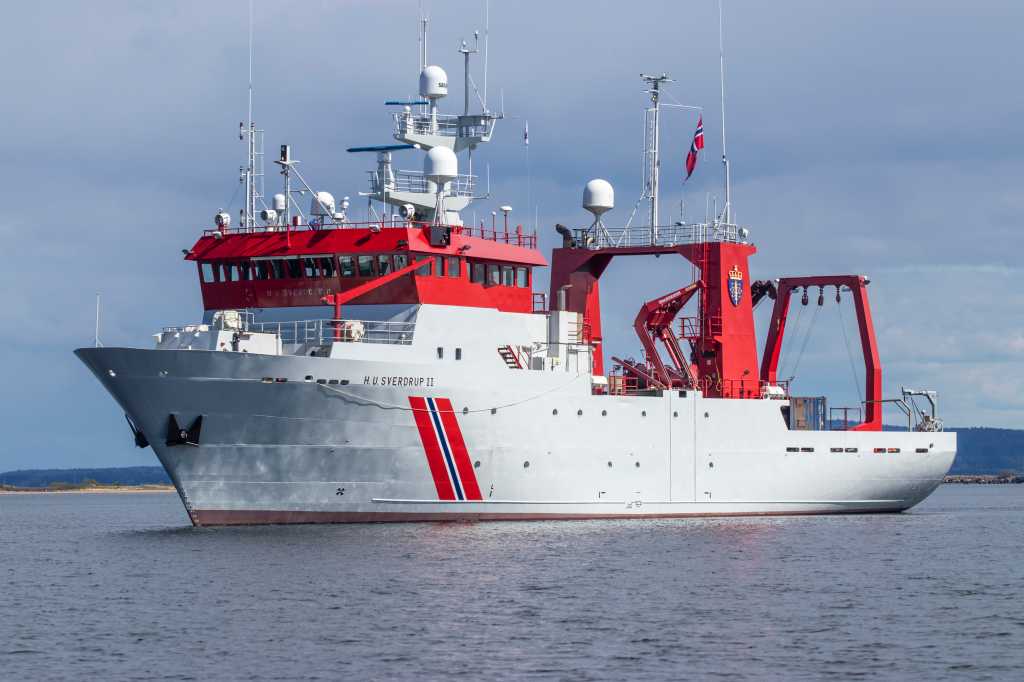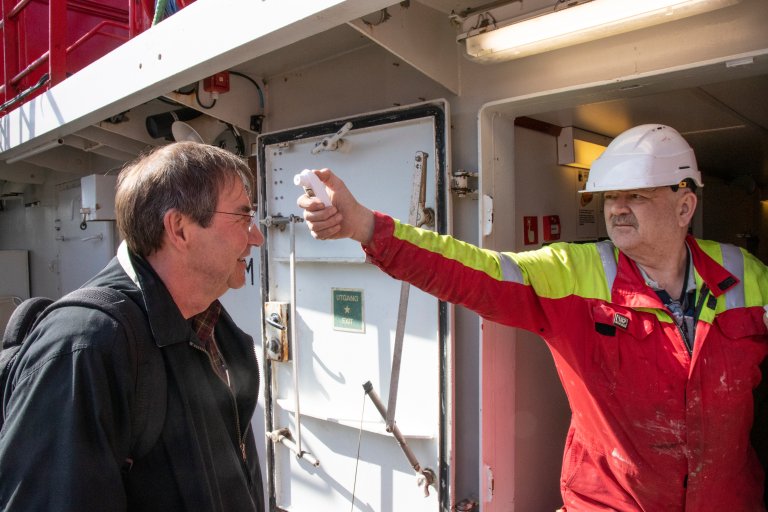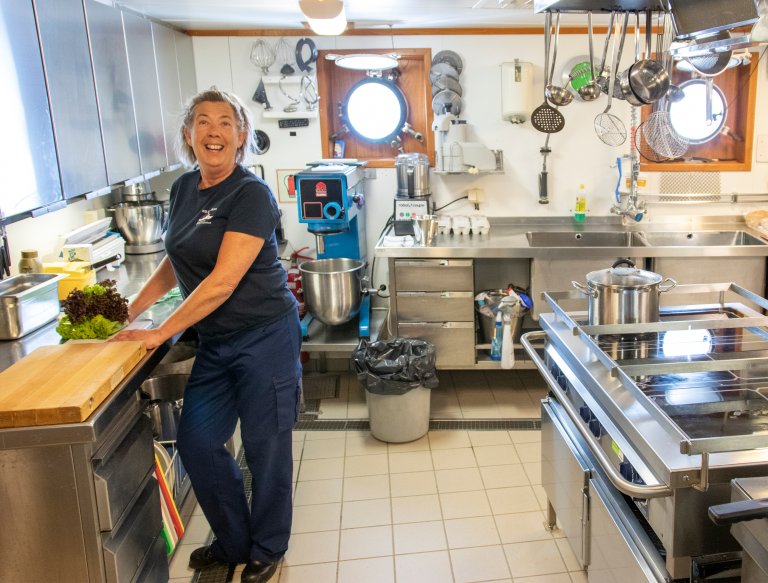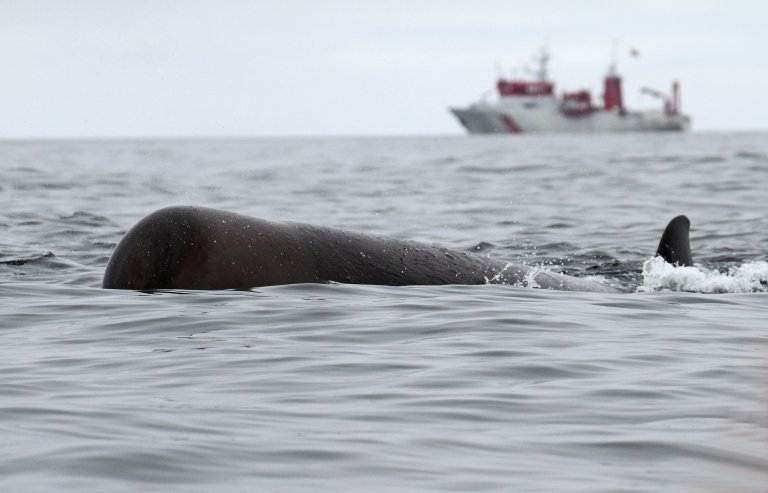How Sverdrup uncovers the deep sea
How do different whales react to noise in the sea? How many shipwrecks are there along the Norwegian coastline and where are they located? What is the condition of chemical ammunitions dumped into the Skagerrak Strait?

Since 1990, the H.U. Sverdrup II has combed Norwegian waters, searching for answers to these questions. Mapping is carried out year-round. This is FFI’s own vessel. The red and white ship is in principle a floating measuring device, 55 metres in length.
The equipment on board can provide many answers. What is down there? What does the seabed look like? How hard or rough is it? What type of sediment can be found? What type of power is required? Are there unknown shipwrecks down there?
Extreme echo sounding
Most refer to FFI’s third research ship simply as Sverdrup. Sverdrup is equipped with a Norwegian-manufactured echo sounder that surpasses all others on the market. The EM 712 Multibeam echo sounder from Kongsberg Maritime enables mapping of the seabed down to 3400 metres, if the conditions are otherwise good. Each time the echo sounder ‘pings’, it captures an enormous amount of data from the seabed. Each of these measurements captures a field on the seabed. These surfaces are referred to as footprints. At a depth of 40 metres, the echo sounder registers an enormous row of these. Details the size of a newspaper page will be clearly visible.
Horten is the home port

It is not possible to simply go aboard. The gangway is blocked. In 2020, the year of the coronavirus, not even management were admitted until everything was thoroughly checked. Able Seaman Arne must measure Research Manager Torgeir Svolsbru’s temperature.
Inspecting the seabed
Svolsbru is in charge of the numerous expeditions with the Sverdrup. He has no doubts that the ship has an important mission for the Norwegian Armed Forces. The topography of the seabed has an impact on the use of sonar, which is the vessel’s most important instrument for orientation in the depths of the ocean. Knowledge of the ocean depths and the landscape of the seabed can potentially be an advantage during submarine operations.
Among Norway’s many research ships, Sverdrup is one of the smallest.
"We don’t want the ship to be much bigger than this. We often operate out in the fjords. And we are often close to land. Larger vessels would be an impediment", says Svolsbru.
A separate community
There are seven crew members. One of them is Ann from Kristiansund. She is a catering assistant for the upcoming expedition. Right now, she is serving lunch. "They used to call people like us ‘mess girls’. While at sea, we become our own little community. Although the composition of researchers varies from time to time, there are so many who return for new expeditions that I know the names of their spouses, kids and dogs", she says.

Sverdrup unit
On the wall of the common room is a picture of the man the ship is named after. Renowned Norwegian oceanographer and meteorologist Harald Ulrik Sverdrup (1888–1957) led the scientific studies during Roald Amundsen’s expedition on the Maud from 1917 to 1924. He became the first director of the Norwegian Polar Institute, founded in 1948.
He is considered one of the leading researchers in the field of oceanography. His work was so widely recognised that he had his own unit of measurement named after him, which measured the ocean currents. A Sverdrup is one cubic kilometre per second.
A lab is vital
The ship’s most important room is the Lab. Here, the windows have been replaced with light from computer screens. Information is often sent directly to clients on land. There are also clients other than the Norwegian Armed Forces. One good example is the Mareano Project. The Institute of Marine Research, the Geological Survey of Norway, and the Norwegian Mapping Authority are all involved, with the Norwegian Environment Agency as the highest authority.
The purpose of the Mareano Project is to map the ocean depths and assess seabed conditions, biodiversity, natural habitats and the chemistry of the sediment in Norwegian coastal and marine areas. On the Sverdrup, researchers are able to study everything from hagfish to old shipwrecks and dumped mustard gas.
Researchers are permitted to load the deck with containers that contain special devices for measurement and, for instance, Hugin, the FFI-developed autonomous underwater vehicle that has become an essential export product for Kongsberg.
Sverdrup has been used as a mother ship for Hugin, when examining the environment around old drilling holes. The vessel has been equipped with methane detectors, to check where methane gas bubbles up from the seabed. Hugin’s side-scan sonar provides an image of an object on the seabed, with a one-centimetre resolution. This has been used in the Skagerrak strait to study many of the shipwrecks with dumped ammunition. The Norwegian Armed Forces use Hugin for minesweeping.
How does the whale react?
The Sverdrup has also been a tool for researchers who have studied the reactions of different types of whales to military sonar. Researchers have utilised the Sverdrup’s rapid light craft and equipment that allow them to attach sonars to whales who come up for air.
These sensors are approximately the size of a mobile phone. They are attached to whales with a suction cup and remain in place for about 24 hours. During this period, researchers are able to collect data on the whale’s movements, before the sensor floats up and is collected by the ship.
The order book is full
Torgeir Svolsbru has determined that FFI’s order book for research vessels is now full. "We have up to 320 expeditions per year", he explains. "As we have a large variety of assignments, very few people grow tired of participating, which is also the case for the researchers who are frequently aboard. We can all agree on the biggest frustration: Sitting in thick fog that often surrounds the waters around Svalbard".


